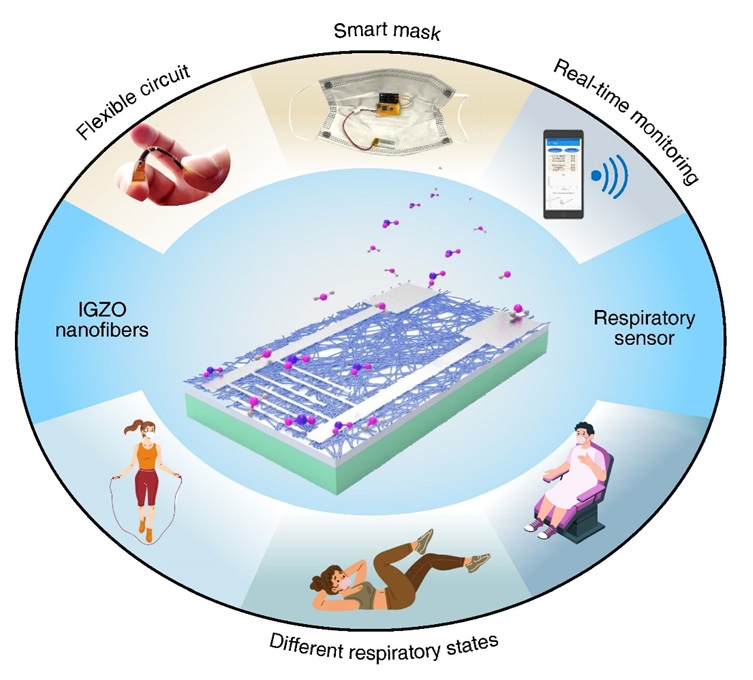Nanofibrous metal oxide semiconductor for sensory face
Published 14 November, 2024
Room-temperature (RT) gas sensors with high sensitivity are essential in low-power Internet-of-Things (IoT) applications, such as smart sensors, wearable devices and mobile robots. Among these, metal oxide semiconductor-based gas sensors are valued for their low production cost, high sensitivity and ease of use, making them suitable for detecting flammable, explosive, toxic, and exhaled gases. However, further fiber diameter reduction and real-time monitoring integration remain underexplored.
In a study published in the KeAi journal Wearable Electronics, a group of researchers from China and South Korea described a new sensor they have developed — ultrathin (~88 nm) amorphous indium gallium zinc oxide (IGZO) nanofibres for wireless and real-time human breath monitoring.
"IGZO nanofibres were created as the charge transport layer to enhance the surface area for gas diffusion using an electrospinning approach,” explains the study's lead author, Qing Ma, a post-doctoral fellow at the School of Electronic Science and Engineering at Southeast University. “The resulting field-effect properties demonstrated an average mobility of 2.2 cm²/V·s and an on/off ratio of 10⁵.”
Notably, the team successfully recorded human breath in fast, normal and deep states, showing the sensor’s fast response and recovery times and stable operation. “By integrating the sensor with a flexible circuit board and mounting them on a face mask, we achieved wireless and real-time monitoring of respiratory status, highlighting its potential for practical applications in health monitoring,” says Ma.
The researchers also found that electrical transport in IGZO nanofibres is driven by oxygen vacancies, water vapor and temperature significantly affect its conductivity. When a voltage is applied, the sensor’s current significantly decreases and quickly recovers during a breath cycle, with a fast response and recovery time of approximately 0.7 seconds.
According to senior and co-corresponding author Binghao Wang, this is a promising solution in the field of personalised healthcare and pandemic prevention.
“An IGZO NF-based sensor integrated into a flexible circuit achieved a compact size of 15 × 35 mm², marking significant progress in the miniaturisation efforts for smart mask technology,” says Wang. “The recorded electrical signals can be visualised via a smartphone equipped with a customised mobile app, underscoring the potential for the widespread adoption of IGZO TFT-based sensors in wearable technology."

Contact author details: Binghao Wang, School of Electronic Science and Engineering, Southeast University, No. 2 Southeast University Road, Jiangning, Nanjing, Jiangsu 211189, China. binghaowang@seu.edu.cn
Haoyang Wang, School of Electronic Science and Engineering, Southeast University, No. 2 Southeast University Road, Jiangning, Nanjing, Jiangsu 211189, China. wanghaoyang@seu.edu.cn
Funder: This work was supported by the National Key Research and Development Programme of China (Grant no. 2024YFE0100400), the National Natural Science Foundation of China (Grant no. 22305036), the Natural Science Foundation of Jiangsu Province (Grant no. BK20220815) and the Fundamental Research Funds for the Central Universities (Grant no. 4006002302). Y. S. would like to thank the Natural Science Research Key Project of the Education Department of Anhui Province (2022AH051377) and the Doctoral Scientific Research Foundation of Suzhou University (2021BSK008) for providing funding.
Conflict of interest: The authors declare that they have no known competing financial interests or personal relationships that could have appeared to influence the work reported in this paper.
See the article: Qing, M., et al., Nanofibrous metal oxide semiconductor for sensory face masks, Wearable Electronics, Volume 1, 2024, Pages 189-194. https://doi.org/10.1016/j.wees.2024.09.001.